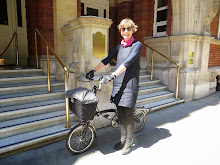For rides less than five miles depends entirely on where I am going - and I dress for that. The only extras I take are a waterproof jacket and my cycling helmet.
If I'm going for a pootle for just for the exercise I wear a sports bra, a baselayer underneath a cycling shirt with a dress or skirt over the top, with leggings underneath.
If I'm going for a pootle for just for the exercise I wear a sports bra, a baselayer underneath a cycling shirt with a dress or skirt over the top, with leggings underneath.
Most of the clothes shops on
the high street have suitable tops, it's just a question of finding the
ones I like. Any recommendations gratefully received!
For day rather than five mile rides I have a couple of Assos short sleeved cycling shirts with zips up the front for temperature control. Because of this I tend to wear them the most.
With the baselayers chosen, the type of tops will vary depending on where you are going and how warm it is.
Armwarmers are a tremendous invention as they do lift how warm you are if the temperature drops a little and they fold up into a small space when they are not needed. When worn correctly you are not supposed to see the join!
With the baselayers chosen, the type of tops will vary depending on where you are going and how warm it is.
Armwarmers are a tremendous invention as they do lift how warm you are if the temperature drops a little and they fold up into a small space when they are not needed. When worn correctly you are not supposed to see the join!
In the very deep winter when temperatures are below 0 degrees I tend to do flat rides not too far from home on main roads that have been gritted in order to avoid cycling on ice! Two Merino baselayers, an Assos baselayer, a longsleeved jersey under a Gore Oxygen jacket has worked perfectly for me. The Gore Oxygen is both windproof and waterproof but breathes to stop you from overheating. Zips up the front allow me to have a thermostat and control my body temperature. I also wear a buff which is not the same as cycling in the buff!
In temperatures around 11 degrees that may go down to four degrees and is not flat I would wear the same but if there is a hill I would remove the jersey towards the bottom of it to allow for my body temperature to rise as I aim for the summit trying to keep up with these guys!
As the weather becomes warmer through the year the jacket may not be required, nor two baselayers. When temperatures are 23 degrees C and above I still wear a merino under a short-sleeved cycling shirt and keep armwarmers and a windstopper gilet on the bike along with an Assos Climatshut jacket which is also a bit of a boil-in-the-bag kind of jacket but stops you from being cold if the temperature drops dramatically, unexpectedly.
I am always looking for tops to wear over leggings that are made of lycra or a stretchy material. Wool is not a good fabric for this as it would become unshapely and would also hold water should it rain - although if I was doing 5 miles or less, this wouldnt be a problem.
Most of the clothes shops on the high street have suitable tops, it's just a question of finding the ones I like. Any recommendations gratefully received!
I am always looking for tops to wear over leggings that are made of lycra or a stretchy material. Wool is not a good fabric for this as it would become unshapely and would also hold water should it rain - although if I was doing 5 miles or less, this wouldnt be a problem.
Most of the clothes shops on the high street have suitable tops, it's just a question of finding the ones I like. Any recommendations gratefully received!




















































